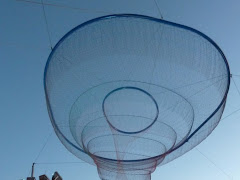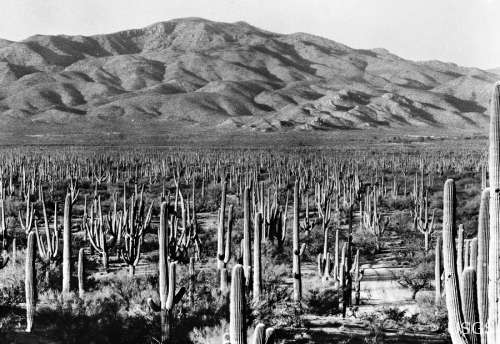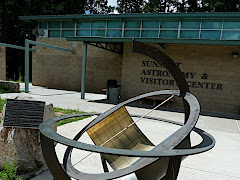vortex
Did they believe in vortexes as we do? asks 8-years old boy. We don’t know, USFS volunteer who shows us around the Palatki site patiently answers. This is a typical answer when it comes to ancient ruins and their builders in the American Southwest. The question however is only typical to Sedona where New Age belief in psychic influence of red phallic protrusions reins supreme. At least boy’s grandfather looks vaguely embarrassed.
antje
Not so long ago we were leading an easy life of sophisticated urbanites in a rented Leather District loft in Boston. We were cultured people. Or at least we tried to be in a city that goes to sleep at 10pm, wakes up before sunrise and then complains that the hip crowd has moved to New York. Mother nature in its infinite wisdom did not give us genes for music, but it endowed us with enough talent for random hacking that we could afford to attend live performances on a regular basis.
experiment
There must be something in the expanse of empty unusable land that invites experimentation. Faced with a desert I have an overwhelming desire to flee to an area with dependable source of water, but others see canvas to be filled with their idea of improved living. We visited three such experiments over couple of days. Chronologically the oldest one is Frank Lloyd Wright’s Taliesin West. Differently than all other Wright’s buildings this one does not really have unforgettable or revolutionary architecture. The most innovative thing about it is the use of local materials, simply rocks found on the desert embedded in concrete. Low structures on the brow of the hill were meant as workspaces. Originally they did not have glass windows. You don’t really need them on the desert; openings shaded with canvas are entirely sufficient. Built as winter campus of the traveling university, so called Wright’s fellowship, the complex is not that conceptually different from ancient Indian pueblos. What you are really after in the desert is to create shade, you get extra points for positioning your passageways to capture fleeting breeze cooled over shallow water pools. Of course now Taliesin has both windows and air conditioning but you still see the design behind an attempt to build a shelter at minimal cost. That’s the most revolutionary and sadly most ignored lesson to be learned from this experiment: using instead of fighting the desert.
underwater

This is not yet another post about scuba diving. Phoenix, Arizona is underwater. There was no flood here. The whole thing is strictly metaphorical: nearly 70% of all homeowners with mortgages owe more than their houses are currently worth. Prices dropped to half of what they were at the peak. That’s why people feel they are drowning. This is of course just an illusion. It’s impossible to drown in a mirage on the desert and - even more importantly - the situation is not as dire as the numbers alone tell us. The fact that many people assume they have no choice but continue paying off their debt, doesn’t magically make their wildly optimistic home evaluation more real.
saguaro

When you see the land covered by cacti: giant saguaros, stocky fish-hook barrels, sprawling prickly pears, thorny ocotillos, you see… pasture. At least when you are a 19th century rancher. It seems that for desperate owners of hungry cows anything greenish spells fodder. Never mind thorns that would make animal-rights activists cringe. And forget about damage to the environment; if saguaros begin to die as result of your grazing practices all you need is a convenient theory: they wither because of unseasonably cold winters and there is nothing one can do. The idea that cows trample young plants preventing cactus forest renewal cannot possibly be true.
fence
Canada? Germany? Poland? was the sequence Natalia was greeted by a street vendor who was trying to guess which country we were from. We were just across the Mexican border in Nogales and it was a bit surprising that he did not even try US. We decided to take it as a compliment. And we needed the compliment rather badly. Apparently we looked really sick. At least based on the frequency with which random strangers suggested we pay a visit to a pharmacy. Taxi and real Mexican food were also offered regularly but the most frequently we heard an assurance that they had what we were looking for.
church
These things tend to happen without any special planning. Pyramids, Easter Island Statutes or elaborate churches in the middle of Indian Pueblos. Civilizations that are on a verge of ecological disaster make this last stab at greatness and spend their meager resources on something completely impractical. If one admits that a culture can commit suicide this is surely a showy way to go. Well at least Pueblo Indians did not invent all those crazy ideas all by themselves. They were coaxed, convinced and threatened by Franciscans who arrived to teach and convert indigenous population. Scraping a living on the dry desert was always hard. Spaniards brought goods: metals, crops, animals - all seemed like an improvement. Accepting their religion might have been seen as a small price for all that bounty. And it’s not like there was any other choice.
canyon

The Grand Canyon is a huge attraction. Literally and - of course - figuratively. It makes various lists of seven wonders of the world. No wonder almost 5 million people a year fulfill a desire to visit. We were in the area and could not resist its pull. The only question was what’s the best way to experience it. The scale is overwhelming, playing tricks with one’s depth perception. Maybe we should fly over in a helicopter? Catch a glimpse from a commercial jet? From space? Alas, tourists are not allowed on space shuttle and won’t be as American space program is drawing to an end. Plus you really need to work on the approach angle to truly appreciate its depth.
volcano
Extinct volcanos are bound to be disappointing. We expect to arrive at the scene of a catastrophe. We end up admiring picturesque hills. I guess Pompeii is an exception: a city buried under ash, destructive power of the explosion preserving ancient artifacts for our benefit. I was thinking of Pompeii when touring Wupatki and Sunset Crater Volcano National Monuments. When the volcano here erupted sometime before 1100, Anasazi civilization was still very much present in the area. I envisioned pueblo-style buildings preserved in ash, hoping for something spared from well meaning, but misguided, 20th century archeologists. But this is not Pompeii. Inhabitants of Wupatki pueblo were not doing so great before the eruption. Porous desert soil, unable to hold water, was lacking nutrients due to over-cultivation. Ash from the volcano acted as a fertilizer and improved water-holding capacity of their fields. Researchers found imprints of corn ears in lava flow. The working hypothesis is that they were offerings intended to stop the eruption. But maybe we underestimate our predecessors: what if they knew the volcano was actually beneficial and fed it corn to keep it going?
forest
Unless you are more hardened to wonderful sights than I am, you will almost fancy yourself in some enchanted spot. You seem to stand on the glass of a gigantic kaleidoscope, over whose sparkling surface the sun breaks in infinite rainbows. You are ankle-deep in such chips as I’ll warrant you never saw from any other woodpile. What do you think of chips from trees that are red moss-agate, and amethyst, and smoky topaz, and agate of every hue? That is exactly the sort of splinters that cover the ground for miles here, around the huge prostrate trunks — some of them five feet through — from which Time’s patient ax has hewn them. Charles Fletcher Lummis wrote these words in 1892.
reservation
If the land you are crossing is desolated yet captivating, then there is an excellent chance you are in what AAA calls the Indian Country. Misappropriation of the name aside the Indian country is where one comes to see incredible geological formations and to witness the progress of a 200 years experiment in civilizing natives. You may think that the concept of bringing the benefits of Western civilization to autochthons is a thing of the past, offensive to modern sensibilities. But consider the restrictions on alcohol on Navajo reservation. The federal government forbids sale of alcohol on Indian lands unless the tribe allows and the Secretary of Interior certifies it. For the rest of us the default option permits alcohol unless local community curbs it. Which is more common than you think: a waitress in Blanding, UT apologetically remarked it’s a dry town (and not because we were in the middle of the desert) when we tried to order beer with our dinner. The result, an utter lack of your favorite libation, is roughly the same but this is not a subtle distinction. Federal laws treat Indians like children. Just look at the extent of tribal jurisdiction over Indian country: the tribal court can only rule in case when both the victim and the perpetrator are Indians and only when the crime is a misdemeanor. Felonies and crimes affecting non-Indians are deemed to difficult to be left to native judges.
pluto
After driving through beer free and - despite of that - beguiling lands of Navajo reservation we found Flagstaff. It’s a refreshingly normal and unexpectedly liberal town in otherwise birthist and tea partying Arizona. Science has yet to analyze a strong correlation between ‘no guns allowed’ signs and good coffee and decent food, but to our relief such a connection exists and can be readily tested in Flagstaff.
price
The biggest attraction of Oklahoma City is something that the city would be much happier without: Oklahoma City National Memorial. But since there is no way to undo what happened, it has to be some consolation that it is a hauntingly beautiful place. It captures the horror of the bombing and it honors the dead. No description gives it justice: you just have to go there and stand between bronze gates and look across the reflecting pond towards 168 empty chairs.
time

Despite all the talking about inevitability of its flow, time is actually quite a flexible concept. We are driving east on the interstate 90 and out of a sudden there is a sign: Central Time Zone. We didn’t cross any state borders and - judging by the total blackness on both sides of the highway - we are in the middle of nowhere. And without much warning one hour of our day is gone. I suppose middle of nowhere makes sense for a time zone change. And the hour that we just gave up wasn’t ours to keep. We borrowed it in July when driving through similarly empty Texas. Although why in South Dakota the time zone change line isn’t straight is beyond me - there are only 4 states in the Union with fewer people per square mile.